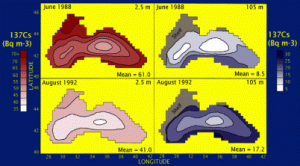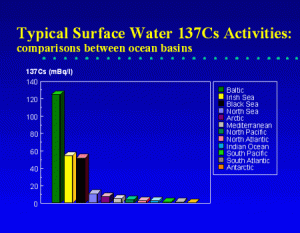Black Sea Studies
Overview
Since the Chernobyl accident in June of 1986, the "Cafe Thorium" lab has been actively pursuing studies of the Black Sea using Chernobyl, weapons testing and naturally occurring radionuclides as tracers of oceanographic processes. These studies have focused on determining the fluxes and rates of sedimentation and water mixing in this unique basin. To learn more about the Black Sea and our work there, pick a topic below, or for the serious reader, check out the CV and request a reprint or two.
Black Sea Introduction
As with any oceanic basin, a wide variety of natural and man-made radionuclides can be detected in the waters, sediments and biota of the Black Sea. In contrast to other oceanic settings however, the Black Sea is unusual in that it is the world's largest anoxic basin, i.e. its deep waters are devoid of oxygen and most marine life. As such, it has been extensively studied due to the unique biogeochemical processes that occur across the oxic/anoxic interface and in the sulfide-rich deep waters. Due to the stability of these anoxic conditions, the Black Sea can also be used as an analog to ancient anoxic seas.
Anoxia is established due to restricted mixing between the brackish surface layers (salinities less than or equal to 18 ppt in upper 100-150m) and the deeper waters (approx. 22 ppt, max. depth = 2200m). Riverine fluxes are dominated by inflow from the Danube and the rivers along the N boundary, and outflow is restricted to the narrow and shallow Bosporus Straits in the SW Black Sea. Mediterranean waters flow into the Black Sea as an undercurrent in the Bosporus Straits. The general counter-clockwise, or cyclonic, circulation pattern leads to a doming of the density, or isopycnal surfaces in the central basin, and a deepening of the depth of sulfide onset along the margins.
For radiochemists, the low redox conditions in the Black Sea provide an interesting site to study redox transformations of radionuclides with multiple oxidation states, such as uranium and plutonium. In addition, soluble tracers, such as 137Cs, 90Sr and 3H introduced from weapons testing and the Chernobyl accident to Black Sea surface waters, can be used to estimate physical exchange rates between the surface and deeper layers. Finally, radionuclides can be used to date the deposition record that has been well preserved in the deep sediments.
Mixing studies between oxic surface waters and anoxic deep waters
The earliest man-made radionuclides were delivered to the Black Sea as fallout from the atmospheric nuclear weapons testing programs which peaked in the mid-1960's. We can estimate the longer term rates of mixing between surface and deep waters from the distribution of the soluble tracers 137Cs, 90Sr and 3H derived from weapons testing.
We have also followed time-series distribution of Chernobyl derived radionuclides which were delivered to Black Sea surface waters in early May of 1986. By following the progression of the highly soluble cesium isotopes from 1986-1992, we can evaluate physical mixing rates bewteen the oxic and anoxic layers on annual time-scales. Presented normalized to salinity, these data show the rapid mixing of the Chernobyl signal throughout the surface mixed layer, through the Cold Intermediate Layer (CIL) and across the strong pycnocline into the upper anoxic water zone.
Buesseler, K. O., H. D. Livingston and S. A. Casso (1991). Mixing between oxic and anoxic waters of the Black Sea as traced by Chernobyl cesium isotopes. Deep-Sea Research, 38(Suppl. 2), S725–S745
Studies of Black Sea Sedimentation
Deep Black Sea sediments are anoxic and hence devoid of the worms, crabs and other critters that typically mix-up radionuclide records in marine sediments. Hence deep basin sediment profiles of man-made 137Cs and 239,240Pu show peaks from weapons testing
fallout, and for 137Cs the more recent Chernobyl accident. 210Pb shows a logarithmic decrease which follows the its radioactive decay half-life of 22.3 years. Accumulation rates are on the order of 70 gm m-2 yr-1, or 0.01-0.02 mm yr-1. Coastal Black Sea sediments are overlain by oxic waters, and hence the sedimentary profiles for Cs and
210Pb are mixed, or bioturbated and do not retain the weapons testing peak. In a core collected in 1988, the Chernobyl derived 134Cs could still be seen in the upper layer. Accumulation rates here are on the order of 3500 gm m-2 yr-1, though this is highly site specific.
For details, search for keyword "Benitez" in: CV
Has the Black Sea really Changes?
While there is ample evidence of recent biological and chemical changes to the Black Sea due to pollution, eutrophication and overfishing, separating climatic or natural changes from man-made one's is not a simple task.. Recently, using historical temperature, salinity,
oxygen and hydrogen sulfide data from the US and FSU, we were able to show that the oxic/anoxic interface is stable on decadal time scales, and not shoaling as others had postulated. Also, the so-called "sub-oxic" zone (i.e. depths where oxygen and sulfide concentrations are less than 5 mM) appears to have been a common feature, though the
extent or thickness of the sub-oxic zone is likely to vary with the intensity of winter mixing and regional variations in mixing between the cyclonic and anticyclonic gyres.
A Comparison of the 137Cs in the Black Sea and other Oceans
Related Links
Research Papers
- Buesseler, K.O. et al.(1987) Chernobyl radionuclides in a Black Sea sediment trap. Nature, 329, 825-828.
- Livingston, H.D. et al. (1988) Characteristics of Chernobyl fallout in the southern Black Sea. In: Radionuclides: A tool for Oceanography, Elsevier, Essex, U.K., pp. 204-216.
- Buesseler, K.O. et al. (1990) Determination of fission-products and actinides in the Black Sea following the Chernobyl accident. Journal of Radioanalytical and Nuclear Chemistry, 37(3), 413-430.
- See more under Scientific Publications


